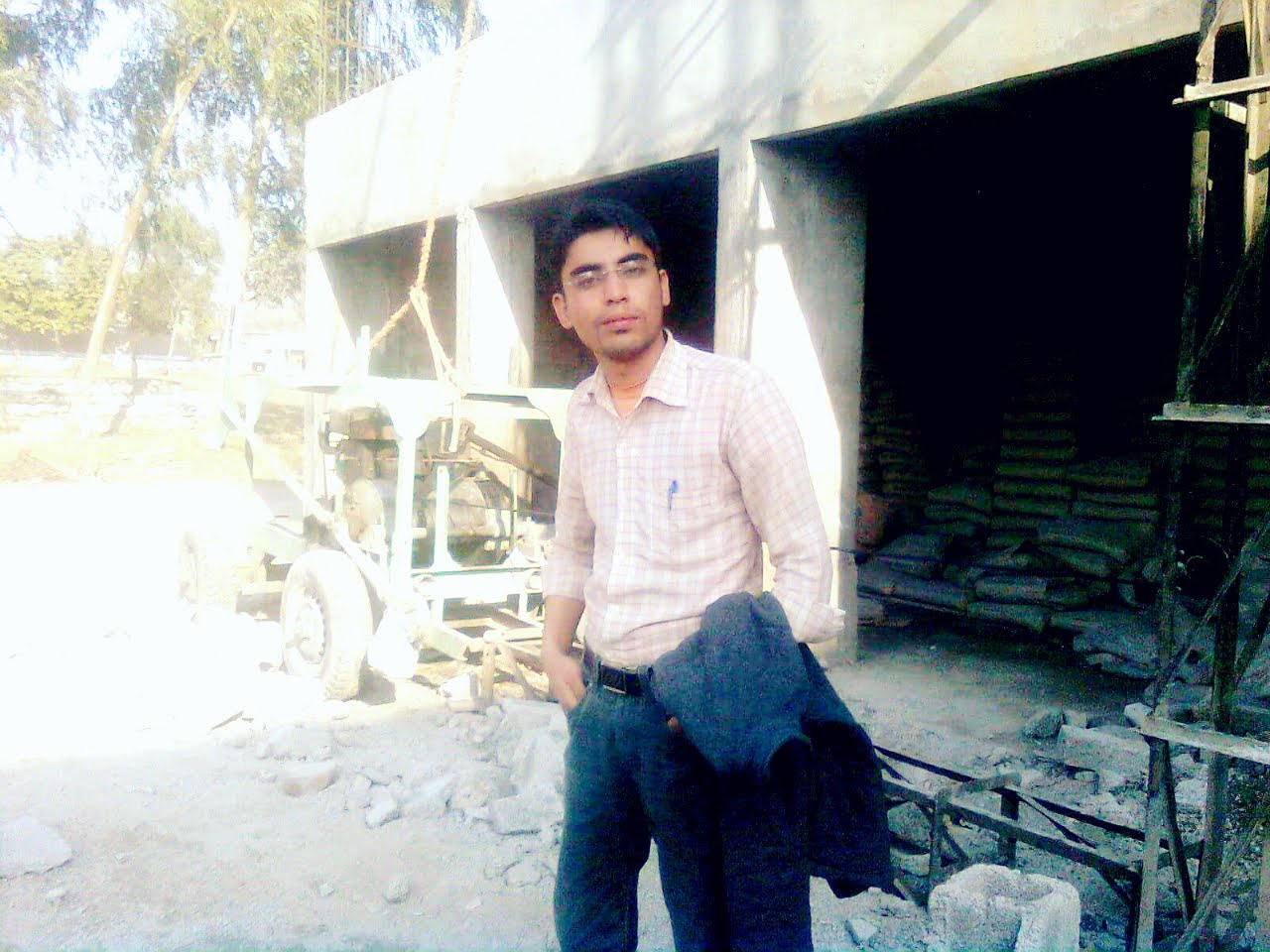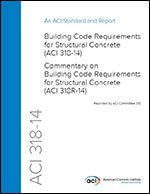318-14: Building Code Requirements for Structural Concrete and Commentary
ACI 318-14 is completely reorganized for greater ease of use
Quantity discounts are not available for this publication.
DESCRIPTION
The “Building Code Requirements for Structural Concrete” (“Code”) provides minimum requirements for the materials, design, and detailing of structural concrete buildings and, where applicable, nonbuilding structures. This Code addresses structural systems, members, and connections, including cast-in-place, precast, plain, nonprestressed, prestressed, and composite construction. Among the subjects covered are: design and construction for strength, serviceability, and durability; load combinations, load factors, and strength reduction factors; structural analysis methods; deflection limits; mechanical and adhesive anchoring to concrete; development and splicing of reinforcement; construction document information; field inspection and testing; and methods to evaluate the strength of existing structures. “Building Code Requirements for Concrete Thin Shells” (ACI 318.2) is adopted by reference in this Code.The Code user will find that ACI 318-14 has been substantially reorganized and reformatted from previous editions. The principal objectives of this reorganization are to present all design and detailing requirements for structural systems or for individual members in chapters devoted to those individual subjects, and to arrange the chapters in a manner that generally follows the process and chronology of design and construction. Information and procedures that are common to the design of members are located in utility chapters.
The quality and testing of materials used in construction are covered by reference to the appropriate ASTM standard specifications. Welding of reinforcement is covered by reference to the appropriate American Welding Society (AWS) standard. Uses of the Code include adoption by reference in a general building code, and earlier editions have been widely used in this manner. The Code is written in a format that allows such reference without change to its language. Therefore, background details or suggestions for carrying out the requirements or intent of the Code provisions cannot be included within the Code itself. The Commentary is provided for this purpose. Some of the considerations of the committee in developing the Code are discussed within the Commentary, with emphasis given to the explanation of new or revised provisions. Much of the research data referenced in preparing the Code is cited for the user desiring to study individual questions in greater detail. Other documents that provide suggestions for carrying out the requirements of the Code are also cited.Technical changes from ACI 318-11 to ACI 318-14 are outlined in the May 2014 issue of Concrete International. Transition keys showing how the code was reorganized are provided on the ACI website on the 318 Resource Page under Topics in concrete.
DOCUMENT DETAILS
Author: ACI Committee 318
Publication Year: 2014
Pages: 520.00
ISBN: 9780870319303
Categories: Codes, Design
Formats: Printed Document, PDF, or Protected PDF/Web View
TABLE OF CONTENTS
CHAPTER 1
GENERAL
1.1—Scope of ACI 318
1.2—General
1.3—Purpose
1.4—Applicability
1.5—Interpretation
1.6—Building official
1.7—Licensed design professional
1.8—Construction documents and design records
1.9—Testing and inspection
1.10—Approval of special systems of design, construction, or alternative construction materials
CHAPTER 2
NOTATION AND TERMINOLOGY
2.1—Scope
2.2—Notation
2.3—Terminology
CHAPTER 3
REFERENCED STANDARDS
3.1—Scope
3.2—Referenced standards
CHAPTER 4
STRUCTURAL SYSTEM REQUIREMENTS
4.1—Scope
4.2—Materials
4.3—Design loads
4.4—Structural system and load paths
4.5—Structural analysis
4.6—Strength
4.7—Serviceability
4.8—Durability
4.9—Sustainability
4.10—Structural integrity
4.11—Fire resistance
4.12—Requirements for specific types of construction
4.13—Construction and inspection
4.14—Strength evaluation of existing structures
CHAPTER 5
LOADS
5.1—Scope
5.2—General
5.3—Load factors and combinations
CHAPTER 6
STRUCTURAL ANALYSIS
6.1—Scope
6.2—General
6.3—Modeling assumptions
6.4—Arrangement of live load
6.5—Simplified method of analysis for nonprestressed
continuous beams and one-way slabs
6.6—First-order analysis
6.7—Elastic second-order analysis
6.8—Inelastic second-order analysis
6.9—Acceptability of finite element analysis
CHAPTER 7
ONE-WAY SLABS
7.1—Scope
7.2—General
7.3—Design limits
7.4—Required strength
7.5—Design strength
7.6—Reinforcement limits
7.7—Reinforcement detailing
CHAPTER 8
TWO-WAY SLABS
8.1—Scope
8.2—General
8.3—Design limits
8.4—Required strength
8.5—Design strength
8.6—Reinforcement limits
8.7—Reinforcement detailing
8.8—Nonprestressed two-way joist systems
8.9—Lift-slab construction
8.10—Direct design method
8.11—Equivalent frame method
CHAPTER 9
BEAMS
9.1—Scope
9.2—General
9.3—Design limits
9.4—Required strength
9.5—Design strength
9.6—Reinforcement limits
9.7—Reinforcement detailing
9.8—Nonprestressed one-way joist systems
9.9—Deep beams
CHAPTER10
COLUMNS
10.1—Scope
10.2—General
10.3—Design limits
10.4—Required strength
10.5—Design strength
10.6—Reinforcement limits
10.7—Reinforcement detailing
CHAPTER 11
WALLS
11.1—Scope
11.2—General
11.3—Design limits
11.4—Required strength
11.5—Design strength
11.6—Reinforcement limits
11.7—Reinforcement detailing
11.8—Alternative method for out-of-plane slender wall analysis
CHAPTER 12
DIAPHRAGMS
12.1—Scope
12.2—General
12.3—Design limits
12.4—Required strength
12.5—Design strength
12.6—Reinforcement limits
12.7—Reinforcement detailing
CHAPTER 13
FOUNDATIONS
13.1—Scope
13.2—General
13.3—Shallow foundations
13.4—Deep foundations
CHAPTER 14
PLAIN CONCRETE
14.1—Scope
14.2—General
14.3—Design limits
14.4—Required strength
14.5—Design strength
14.6—Reinforcement detailing
CHAPTER 15
BEAM-COLUMN AND SLAB-COLUMN JOINTS
15.1—Scope
15.2—General
15.3—Transfer of column axial force through the floor system
15.4—Detailing of joints
CHAPTER 16
CONNECTIONS BETWEEN MEMBERS
16.1—Scope
16.2—Connections of precast members
16.3—Connections to foundations
16.4—Horizontal shear transfer in composite concrete flexural members
16.5—Brackets and corbels
CHAPTER 17
ANCHORING TO CONCRETE
17.1—Scope
17.2—General
17.3—General requirements for strength of anchors
17.4—Design requirements for tensile loading
17.5—Design requirements for shear loading
17.6—Interaction of tensile and shear forces
17.7—Required edge distances, spacings, and thicknesses to preclude splitting failure
17.8—Installation and inspection of anchors
CHAPTER 18
EARTHQUAKE-RESISTANT STRUCTURES
18.1—Scope
18.2—General
18.3—Ordinary moment frames
18.4—Intermediate moment frames
18.5—Intermediate precast structural walls
18.6—Beams of special moment frames
18.7—Columns of special moment frames
18.8—Joints of special moment frames
18.9—Special moment frames constructed using precast concrete
18.10—Special structural walls
18.11—Special structural walls constructed using precast concrete
18.12—Diaphragms and trusses
18.13—Foundations
18.14—Members not designated as part of the seismicforce-resisting system
CHAPTER 19
CONCRETE: DESIGN AND DURABILITY REQUIREMENTS
19.1—Scope
19.2—Concrete design properties
19.3—Concrete durability requirements
19.4—Grout durability requirements
CHAPTER 20
STEEL REINFORCEMENT PROPERTIES, DURABILITY, AND EMBEDMENTS
20.1—Scope
20.2—Nonprestressed bars and wires
20.3—Prestressing strands, wires, and bars
20.4—Structural steel, pipe, and tubing for composite columns
20.5—Headed shear stud reinforcement
20.6—Provisions for durability of steel reinforcement
20.7—Embedments
CHAPTER 21
STRENGTH REDUCTION FACTORS
21.1—Scope
21.2—Strength reduction factors for structural concrete members and connections
CHAPTER 22
SECTIONAL STRENGTH
22.1—Scope
22.2—Design assumptions for moment and axial strength
22.3—Flexural strength
22.4—Axial strength or combined flexural and axial strength
22.5—One-way shear strength
22.6—Two-way shear strength
22.7—Torsional strength
22.8—Bearing
22.9—Shear friction
CHAPTER 23
STRUT-AND-TIE MODELS
23.1—Scope
23.2—General
23.3—Design strength
23.4—Strength of struts
23.5—Reinforcement crossing bottle-shaped struts
23.6—Strut reinforcement detailing
23.7—Strength of ties
23.8—Tie reinforcement detailing
23.9—Strength of nodal zones
CHAPTER 24
SERVICEABILITY REQUIREMENTS
24.1—Scope
24.2—Deflections due to service-level gravity loads
24.3—Distribution of flexural reinforcement in one-way slabs and beams
24.4—Shrinkage and temperature reinforcement
24.5—Permissible stresses in prestressed concrete flexural members
CHAPTER 25
REINFORCEMENT DETAILS
25.1—Scope
25.2—Minimum spacing of reinforcement
25.3—Standard hooks, seismic hooks, crossties, and minimum inside bend diameters
25.4—Development of reinforcement
25.5—Splices
25.6—Bundled reinforcement
25.7—Transverse reinforcement
25.8—Post-tensioning anchorages and couplers
25.9—Anchorage zones for post-tensioned tendons
CHAPTER 26
CONSTRUCTION DOCUMENTS AND
INSPECTION
26.1—Scope
26.2—Design criteria
26.3—Member information
26.4—Concrete materials and mixture requirements
26.5—Concrete production and construction
26.6—Reinforcement materials and construction requirements
26.7—Anchoring to concrete
26.8—Embedments
26.9—Additional requirements for precast concrete
26.10—Additional requirements for prestressed concrete
26.11—Formwork
26.12—Concrete evaluation and acceptance
26.13—Inspection
CHAPTER 27
STRENGTH EVALUATION OF EXISTING STRUCTURES
27.1—Scope
27.2—General
27.3—Analytical strength evaluation
27.4—Strength evaluation by load test
27.5—Reduced load rating
COMMENTARY REFERENCES
APPENDIX A
STEEL REINFORCEMENT INFORMATION
APPENDIX B
EQUIVALENCE BETWEEN SI-METRIC, MKSMETRIC, AND U.S. CUSTOMARY UNITS OF NONHOMOGENOUS EQUATIONS IN THE CODE
Download or PDF View Link





